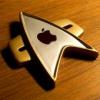
Browsere actualizate pentru Mac-urile cu PowerPC
Posted by
Tudor Vedeanu
,
in
PowerPC
02 March 2013 -




 ·
1200 views
·
1200 views




 ·
1200 views
·
1200 views
Nu știu ce s-a întâmplat cu cohorta de Mac-uri cu procesor PowerPC, care au populat Pământul înainte de anul 2006 (anul în care Apple a trecut la Intel), însă nu cred că au dispărut complet din peisaj. Cel puțin vechiturile mele din generațiile 2004-2005 încă merg binișor, așa că nu se pune problema să fie date la gunoi. Deși aproape nici un producător de software nu-și mai actualizează aplicațiile pentru a funcționa pe aceste Mac-uri, la capitolul browsere stăm relativ bine. Mă refer la browserele care încă sunt actualizate și funcționează în Mac OS X Leopard (în Tiger situația nu e prea roză, iar mai jos de Tiger nu merită să discutăm).
De ce e important să avem un browser actualizat? Nu putem folosi, de exemplu, o versiune de Netscape de acum 8 ani? Probabil că da, însă o să avem surpriza că unele pagini nu sunt afișate corect, din cauză că aceste browsere abandonate de producători nu au avut cum să țină pasul cu evoluția standardelor web din ultimii ani. Nici Apple nu a mai actualizat versiunile de Safari pentru PowerPC. În Leopard/PPC avem Safari 5.0.6, un browser încă bunicel, cu un suport decent pentru standardele web actuale.
Dar dacă vrem să fim la curent pe PowerPC în Leopard cu "ultimele răcnete" din domeniul tehnologiei web, atunci avem trei opțiuni.
1. Leopard Webkit
Safari își bazează funcționarea pe Webkit, care este motorul de afișare a paginilor web. Webkit-ul oficial este actualizat constant, însă numai pentru Mac-urile cu procesor Intel. Dacă vreți totuși un Webkit mai nou, atunci puteți folosi Leopard Webkit. Nu e un browser complet nou, ci același Safari 5.0.6 dar cu un motor nou pentru afișarea paginilor. Se mișcă cam greoi în JavaScript, dar e campion la facilitățile HTML5 și CSS3 implementate, fiind la egalitate cu ultimele build-uri de Webkit pentru procesoare Intel.
2. Stainless
Stainless este tot un browser bazat pe Webkit. Creatorii lui au încercat să-l facă asemănător cu Google Chrome. Este probabil singurul browser pentru PowerPC care funcționează în sistem multi-proces (fiecare tab e un proces separat; dacă un tab crapă, browserul și celelalte tab-uri rezistă). Iar dacă aveți instalat Leopard Webkit, atunci puteți folosi motorul actualizat pentru afișarea paginilor și în Stainless.
3. TenFourFox.
TenFourFox este un build de Firefox pentru PowerPC. Prin urmare arată și funcționează identic cu Firefox. Este (după știința mea) singurul browser actualizat care funcționează și în Mac OS X 10.4 Tiger, fiind opțiunea universală pentru toți posesorii de Mac-uri cu procesor PowerPC de la G3 până la G5. TenFourFox este și cel mai bun browser la capitolul JavaScript, fiind mult mai rapid decât Safari sau Leopard Webkit.
Ce-ar mai fi de adăugat? Mai există browsere care încă oferă versiuni PPC relativ noi. Camino e o rudă de-a lui Firefox, care însă are un motor de afișare vechi. La fel ca și OmniWeb sau iCab, browsere bazate pe versiuni Webkit mai vechi chiar și decât cea din Leopard. Le puteți folosi dacă vă plac, însă din punct de vedere al dezvoltării sunt moarte.
De ce e important să avem un browser actualizat? Nu putem folosi, de exemplu, o versiune de Netscape de acum 8 ani? Probabil că da, însă o să avem surpriza că unele pagini nu sunt afișate corect, din cauză că aceste browsere abandonate de producători nu au avut cum să țină pasul cu evoluția standardelor web din ultimii ani. Nici Apple nu a mai actualizat versiunile de Safari pentru PowerPC. În Leopard/PPC avem Safari 5.0.6, un browser încă bunicel, cu un suport decent pentru standardele web actuale.
Dar dacă vrem să fim la curent pe PowerPC în Leopard cu "ultimele răcnete" din domeniul tehnologiei web, atunci avem trei opțiuni.
1. Leopard Webkit
Safari își bazează funcționarea pe Webkit, care este motorul de afișare a paginilor web. Webkit-ul oficial este actualizat constant, însă numai pentru Mac-urile cu procesor Intel. Dacă vreți totuși un Webkit mai nou, atunci puteți folosi Leopard Webkit. Nu e un browser complet nou, ci același Safari 5.0.6 dar cu un motor nou pentru afișarea paginilor. Se mișcă cam greoi în JavaScript, dar e campion la facilitățile HTML5 și CSS3 implementate, fiind la egalitate cu ultimele build-uri de Webkit pentru procesoare Intel.
2. Stainless
Stainless este tot un browser bazat pe Webkit. Creatorii lui au încercat să-l facă asemănător cu Google Chrome. Este probabil singurul browser pentru PowerPC care funcționează în sistem multi-proces (fiecare tab e un proces separat; dacă un tab crapă, browserul și celelalte tab-uri rezistă). Iar dacă aveți instalat Leopard Webkit, atunci puteți folosi motorul actualizat pentru afișarea paginilor și în Stainless.
3. TenFourFox.
TenFourFox este un build de Firefox pentru PowerPC. Prin urmare arată și funcționează identic cu Firefox. Este (după știința mea) singurul browser actualizat care funcționează și în Mac OS X 10.4 Tiger, fiind opțiunea universală pentru toți posesorii de Mac-uri cu procesor PowerPC de la G3 până la G5. TenFourFox este și cel mai bun browser la capitolul JavaScript, fiind mult mai rapid decât Safari sau Leopard Webkit.
Ce-ar mai fi de adăugat? Mai există browsere care încă oferă versiuni PPC relativ noi. Camino e o rudă de-a lui Firefox, care însă are un motor de afișare vechi. La fel ca și OmniWeb sau iCab, browsere bazate pe versiuni Webkit mai vechi chiar și decât cea din Leopard. Le puteți folosi dacă vă plac, însă din punct de vedere al dezvoltării sunt moarte.









